Loretto Roots: Down the Mississippi where Histories and Cultures Interact
Posted on May 1, 2023, by Annie Stevens CoL
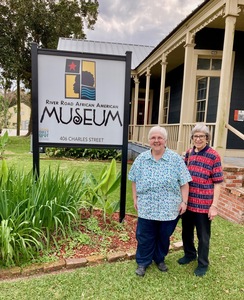
Photo Courtesy of Annie Stevens
Barbara Ann Barbato and I spent a week of March driving through history along the lower Mississippi River Valley, where Loretto established convents and schools during the 1820s-1840s. We not only visited sites where Loretto had lived (few actual buildings remain), but we immersed ourselves in the landscape, culture and history as told by local people today.
Traveling through southeastern Missouri, we stopped in Ste. Genevieve, Perryville and Cape Girardeau. The former Loretto convent, Meilleur House, in Ste. Genevieve is part of the historic district of the city where Father Charles Nerinckx died in 1824. In Perryville, a stone monument near old St. Mary ’s Seminary marks the place where Loretto lived and taught at Bethlehem from 1823 until the mid-1840s, when they relocated to Cape Girardeau. Nearby, the Trail of Tears State Park commemo- rates the forced migration of the Cherokee people from North Carolina to Oklahoma during that same era.
Following the river south into Tennessee, we visited the Alex Haley Museum in Henning, where stories of ancestors inspired his landmark book, “Roots.” From there, we traveled the Natchez Trace parkway across Mississippi, following in the footsteps of early traders, stopping to read numerous historical signs that described the effects of the intersections of Native, European and African cultures.
In Jackson, Miss., we explored the Smith Robertson Museum located in the city’s first public school built for Black children in the early 1900s. A special exhibit on “Granny Midwives” in the African American communities was especially compelling, not- ing that among the first Africans enslaved in Virginia in 1619 were a griot (West African storyteller and historian), a midwife and a baby. Among the permanent exhibits were displays by Black and Creole artists and quilters. Immersive experiences included walking a timeline from ancient African kingdoms through a replica ship’s hold to American ports where Africans were enslaved.
At the end of the Natchez Trace, we saw one of the most infamous slave auction sites, Forks of the Road, where out-door memorials tell the history and honor the thousands of enslaved persons who were “sold down the river” there.
Our first stop in Louisiana was at Donaldsonville, a thriving port city in 1825 when Loretto Sisters Joanna Miles, Rose Elder and Regina Cloney arrived in Bayou Lafourche. Here we visited the River Road African American Museum where we learned that their mission is not only to preserve stories of the past, but to create new opportunities for community development, restoring historic buildings for use as residences and community arts centers and planting neighborhood gardens.
A few miles down the bayou, we stopped at the Church of the Assumption in Plattenville where Sisters of Loretto lived from 1825-1828. Their limited French and difficulties with mail correspondence to the Loretto houses in Missouri and Kentucky were enormous challenges. Sisters Rose and Regina eventually joined the Society of the Sacred Heart, while Joanna returned home to marry and raise four children. The old wooden church and convent no longer exist, but as we continued down the bayou, we thought about how this location shaped planning for later Loretto missions into new languages and cultures (New Mexico, China, Latin America, Pakistan).
We spent the weekend in Thibodaux at the Carmel Inn and Suites along Bayou Lafourche. We visited the Jean Lafitte Wetlands Acadian Cultural Center and enjoyed a boat tour on the bayou with a national park ranger who is a biologist, able to explain the story of the river and its ecology. We toured four historic sites and sugar plantations, E. D. White Historic Site, Laurel Valley Sugar Plantation, Laura Plantation and Whitney Plantation. Each place showed the full history of the diverse people who lived and worked there.
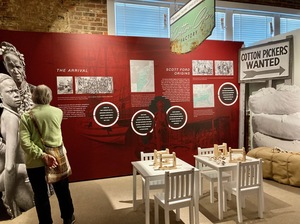
Photo by Annie Stevens
The Whitney Plantation was one of the most powerful examples of truth telling, as it focuses entirely on the African American experience through interactive and reflective methods. Visitors are given headphones then encouraged to move about the many outdoor exhibit areas at their own pace, pausing to sit and contemplate the Wall of Honor (much like the Vietnam Memorial) where names of thousands of enslaved persons are listed. There are stories from interviews with former enslaved persons in the 1930s by the WPA detailing daily life. A series of life-size sculptures by Woodrow Nash depicts former slaves as the children they were at the time of the Emancipation Proclamation. Today, many New Orleans area school children are coming to Whitney as part of their Louisiana history study and their creative responses to the freedom seekers are on display at the visitors center.
Heading north, we stopped at Arkansas Post, one of three locations in Arkansas where Sisters of Loretto lived between 1838 and 1845. As in Louisiana, the short-lived Arkansas missions experienced many challenges — hostile environments, lack of money and loneliness. The site of the Loretto property in Little Rock is now the parking lot for the cathedral. Because of shifts in the Arkansas River, the St. Mary’s landing location near Pine Bluff is now under water. The only Loretto artifact that remains is Mother Agnes Hart’s memorial stone, erected decades after her 1839 death, in the relocated cemetery at Plum Bayou. At the Arkansas Post National Memorial we remembered all those early Loretto women who came before us to follow the rivers to the next place of mission work.
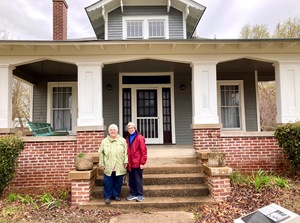
Photo courtesy of Annie Stevens
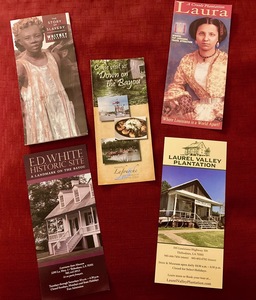
Photo by Annie Stevens
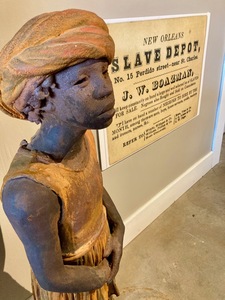
Photo by Annie Stevens
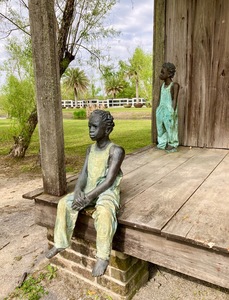
Photo by Annie Stevens
